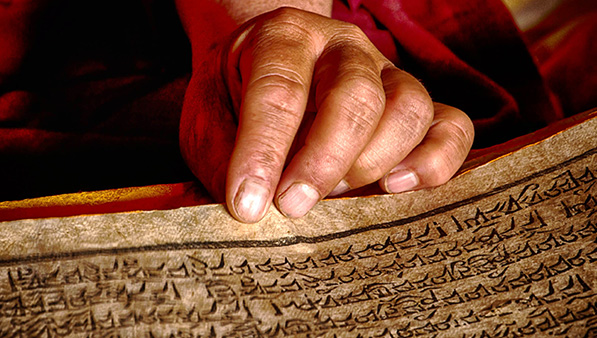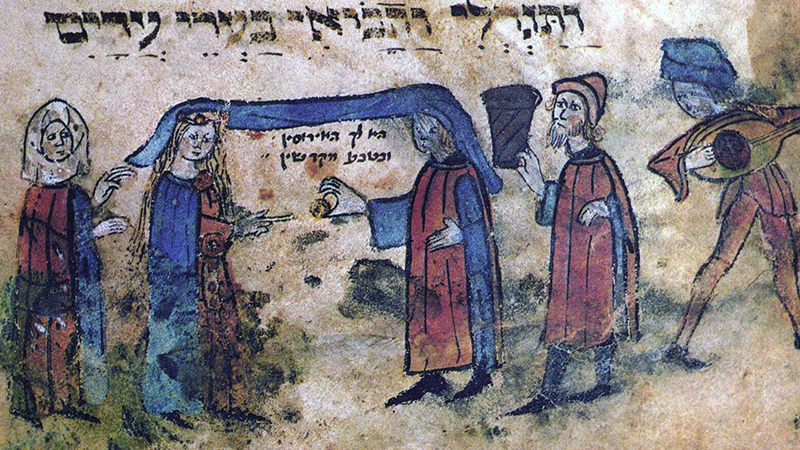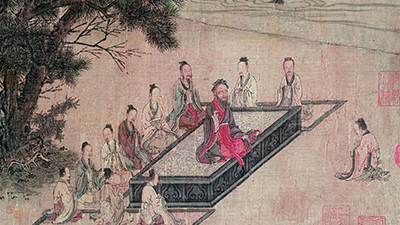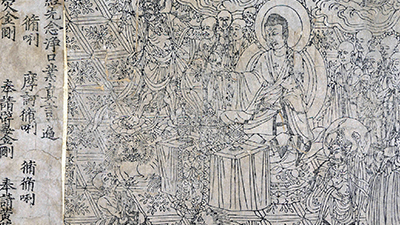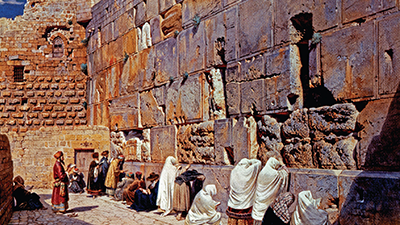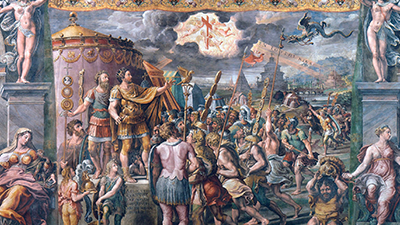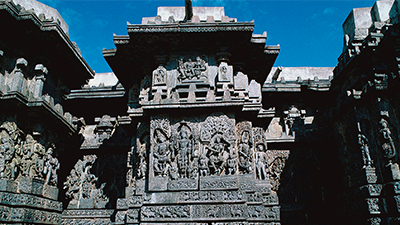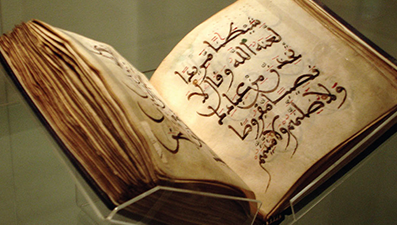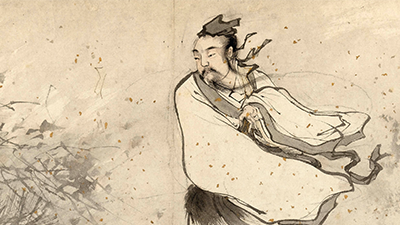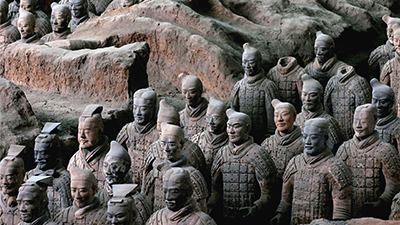Comparing Portable Belief Systems
Teacher Resources
Driving Question: What did the portable belief systems that emerged or spread in this period share in common?
Many of the belief systems that spread along trade routes did not require a person to be in a local area to take part in rituals and practices. We call these “portable” beliefs systems, some of which later transformed into universal systems, or what we now call world religions. In this lesson, you’ll evaluate the similarities and differences among the major portable belief systems of this period.
Learning Objectives:
- Understand and evaluate belief systems and how some of these systems transformed into world religions.
- Evaluate why belief systems spread during this era and how these beliefs influenced human communities and the formation of societies and empires.
- Use the historical thinking practice of comparison to examine the similarities and differences between portable belief system.
Vocab Terms:
- animism
- assimilate
- belief system
- caste
- convert
- monotheism
- pantheon
- persecute
- pilgrimage
Opener: Comparing Portable Belief Systems
To teach this lesson step, refer to page 3 of the Lesson 4.2 Teaching Guide.
Discussing belief systems can sometimes be tricky. Take a look at our Teaching Sensitive Topics in Social Studies Guide for support.
Belief Systems Around the World
To teach this lesson step, refer to page 4 of the Lesson 4.2 Teaching Guide.
Want to dig deeper into comparison? Take a look at the Comparison Topic Page which provides a ton of resources for supporting students in learning this skill.
For reading strategies check out the OER Project Reading Overview.
By comparing the history and teachings of several belief systems, we can learn a lot about how people thought—and think. Use these articles and activity to begin your exploration of world religions.
-
Guiding Questions
-
Before you read
Preview the questions below, and then skim the article. Be sure to look at the section headings and any images.
While you read
Look for answers to these questions:
- What is a belief system? How is it distinct from religion?
- How did the development of the state, hierarchies, and specialization contribute to the development of religions?
- What does it mean to say that a religion is portable?
- What does it mean to say that a religion is universal?
- How did systems of belief change people’s behaviors?
After you read
Respond to this question: Do you think it’s more useful to think about belief systems through the networks frame or the communities frame?
-
Guiding Questions
-
Before you read
Preview the questions below, and then skim the article. Be sure to look at the section headings and any images.
While you read
Look for answers to these questions:
- What is the Jewish diaspora, and how did it influence Judaism in the period from 1200 to 1450?
- What effect did the development of Hinduism have on societies in South Asia?
- What allowed for the rapid spread of Buddhism? Where did it spread?
- How did interaction with the Roman Empire change the development of early Christianity?
- What are the Five Pillars of Islam?
After you read
Respond to this question: What does this article suggest about the ways that communities change over time?
-
Guiding Questions
-
Before you read
Preview the questions below, and then skim the article. Be sure to look at the section headings and any images.
While you read
Look for answers to these questions:
- What was the period in which Confucius developed his ethic and shared it with others like?
- How did Confucius argue that order could be restored?
- What were the principal ideas of Confucian social order?
- What does it mean that Confucianism was a political belief system?
After you read
Respond to this question: What does this reading suggest about the relationship between the belief systems and the government in China during this period?
-
Guiding Questions
-
Before you read
Preview the questions below, and then skim the article. Be sure to look at the section headings and any images.
While you read
Look for answers to these questions:
- What is the core belief of Buddhism, and how was this a challenge to Vedic beliefs?
- What are the Four Noble Truths?
- Who could follow the Eightfold Path easily, and why? How did Mahayana Buddhism change this?
- How did Buddhism change when it entered China?
After you read
Respond to this question: Why do you think we still consider Buddhism a single belief system, even though it changed so much when it moved to new places?
-
Guiding Questions
-
Before you read
Preview the questions below, and then skim the article. Be sure to look at the section headings and any images.
While you read
Look for answers to these questions:
- What is the Torah?
- What was the covenant the Hebrews believed they had with Yahweh?
- How did life for the Hebrews change as they shifted from pastoral to settled farming?
- How did the Hebrews rule themselves following the defeat of the Philistines?
- How did the Hebrews maintain cohesion after their exile from Canaan?
After you read
Respond to these questions: What do you think was new or different about Judaism as a community? What about as a network?
-
Guiding Questions
-
Before you read
Preview the questions below, and then skim the article. Be sure to look at the section headings and any images.
While you read
Look for answers to these questions:
- What was Judea like under Roman rule during the life of Jesus?
- How were the teachings of Jesus similar to and different from those of Judaism?
- How were the teachings of Jesus recorded and spread?
- What was the role of women in early Christianity?
- How did Christianity become the official religion of the Roman Empire?
After you read
Respond to this question: Was there anything new or different about the networks through which Christianity spread?
-
Guiding Questions
-
Before you read
Preview the questions below, and then skim the article. Be sure to look at the section headings and any images.
While you read
Look for answers to these questions:
- How did Hinduism emerge in South Asia?
- How do Hindus believe a person’s status is determined?
- Why did Hinduism spread? What made it appealing to people?
- How was the social hierarchy organized under Hinduism?
After you read
Respond to this question: What role might networks and communities have played in Hinduism’s expansion (and lack of expansion)?
-
Guiding Questions
-
Before you read
Preview the questions below, and then skim the article. Be sure to look at the section headings and any images.
While you read
Look for answers to these questions:
- Why were Muhammad and his successors so successful at spreading Islam?
- What are the Five Pillars of Islam?
- How did the umma split in Islam’s history?
- What were the central practices of Sufism?
- How did early Islamic society view women?
After you read
Respond to these questions: Is the Islamic concept of umma something new in the history of communities? Why or why not?
Closer: Comparing Portable Belief Systems
To teach this lesson step, refer to page 15 of the Lesson 4.2 Teaching Guide.
Prompt parsing is just one part of helping students become strong historical writers. Read "Writing historical essays - not as easy as it sounds!" to learn more.
You have questions about the questions! We have answers! You’ll revisit the Question Parsing Tool to help figure out what prompts are asking you to do.
Writing: Comparing Chinese Belief Systems
To teach this lesson step, refer to page 15 of the Lesson 4.2 Teaching Guide.
In this writing activity, you’ll use evidence from sources to support an argument that responds to the prompt: Compare the similarities and differences between early Chinese philosophies about how a state should be ruled.
Beliefs in Ancient China
To teach this lesson step, refer to page 16 of the Lesson 4.2 Teaching Guide.
If you’ve ever heard of people trying to find peace by being one with nature and wondered what that meant, you may be interested in reading about Daoism, a belief system that emphasizes harmony with your surroundings.
-
Guiding Questions
-
Before you read
Preview the questions below, and then skim the article. Be sure to look at the section headings and any images.
While you read
Look for answers to these questions:
- What is the core concept of Daoism?
- Daoism and Confucianism seem to have emerged about the same time. How did they differ?
- Confucianism became very important in governance and was widely adopted among the powerful in this era. What about Daoism?
- Confucianism tended to have a gender hierarchy in which men were more respected and powerful than women. How did Daoism treat gender?
After you read
Respond to this question: What do you think a state would look like if it adopted Daoism as its governing belief system?
-
Guiding Questions
-
Before you read
Preview the questions below, and then skim the article. Be sure to look at the section headings and any images.
While you read
Look for answers to these questions:
- How was Legalism a response to conditions in Chinese society during the Warring States period?
- How is Legalism different from Confucianism?
- What were some important contributions of Legalism?
- How do the excerpts from Han Feizi’s writing show Legalist thought?
After you read
Respond to these questions: How would you compare Legalism to the other major belief systems in ancient China (Buddhism, Daoism, Confucianism)? Do you think these four systems are compatible within the same community?



